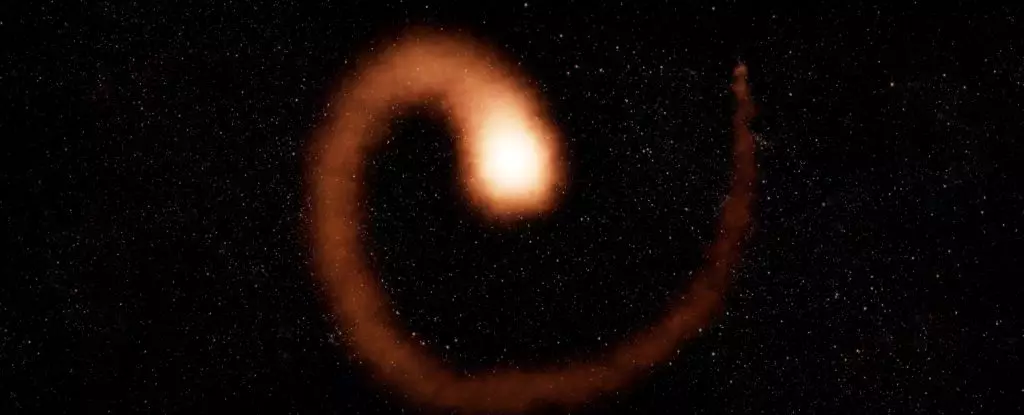Far beyond the confines of our solar system, in a remote corner of the cosmos, the intricate dance of death and regeneration unfolds. The extraordinary star system known as Wolf-Rayet 104, commonly referred to as the Pinwheel Nebula, is captivating the minds of astronomers and enthusiasts alike with its mesmerizing spiral form. As discussions around its fate intensify, new revelations suggest that this cosmic marvel may not pose the imminent threat to Earth that once seemed likely. Instead, it has evolved into an elegant tapestry of stellar phenomena that showcases the ever-unpredictable nature of the universe.
The Posthumous Beauty of Wolf-Rayet Stars
Wolf-Rayet stars, often characterized by their enormous size and astonishing luminosity, epitomize the picturesque nature of stellar mortality. WR 104, a particularly compelling specimen, boasts a mass approximately 13 times that of our Sun and is relatively young at about 7 million years old. The star is on the brink of collapse, losing mass at an extraordinary rate, subsequently creating stunning visual displays as its winds collide with those of its binary companion. The systemic interaction generates pulsating waves of brilliance that reach across the universe, captivating observers with their alluring forms. The sight of a Wolf-Rayet star shedding its veil of dust is more than just a cosmic event; it serves as a profound reminder of the dance of creation and destruction within celestial realms.
Unwrapping the Spiral: The Nature of Binary Interaction
Recent observations have redefined our understanding of Wolf-Rayet 104’s structure, specifically its interaction with its binary partner—a hot, luminous OB star. Grant Hill, an esteemed astronomer at the Keck Observatory, and his team scrutinized data amassed since 2001 to decode the relationship between the two celestial giants. Contrary to their initial assumptions about a face-on alignment, the team’s findings revealed a tilted orbital system, angled at roughly 30 to 40 degrees from the Earth’s perspective. This tilted orientation serves a dual purpose: it paints a more complex portrait of their interaction and shields our home planet from a catastrophic gamma-ray burst—a potential calamity that could accompany a supernova event.
A Cosmic Relief: Earth Safe from Impending Gamma Rays
Astrophysicists had previously fretted over Wolf-Rayet 104’s potential explosion, fearing the ramifications of its gamma-ray output directed at Earth. The discovery that the stars’ poles do not align with our viewpoint has allayed those concerns, allowing us to breathe a sigh of relief. The tilted orbital configuration indicates that any energetic outflows will veer away from Earth, thus sparing our planet from the destructive radiation associated with such a stellar cataclysm. It is a remarkable stroke of fortune, as these gamma-ray bursts are known for their treacherous potential to deplete ozone layers and create planetary havoc.
The Mysterious Dust Spiral and Its Implications
However, this newfound revelation also leads to intriguing questions. The spiral dust formed by the interaction of stellar winds does indeed seem to face directly towards Earth—a paradox that challenges our current models of stellar evolution and dynamics. Why, despite the angles of the binary stars, would the dust exhibit such a curious alignment? This observation hints at complex mechanisms at play within the stellar winds and their aftermath that astronomy has yet to fully comprehend. The intricacies of this cosmic ballet expose an underlying mystery, suggesting that the universe is, as always, full of surprises waiting to unfold.
The Endless Quest for Cosmic Knowledge
The exploration of Wolf-Rayet 104 exemplifies the essence of astronomical inquiry—where each answer births new questions and complexities. Hill highlights the sense of wonder that characterizes this field of research, emphasizing that astronomers may seek clarity but often arrive at unexpected revelations. As scientists continue to unravel the enigmas surrounding Wolf-Rayet stars and their interactions, we gain not only insights into the cosmos but also a deeper appreciation for its dazzling yet unpredictable nature.
In this era of astronomical discovery, Wolf-Rayet 104 stands as a testament to the beauty and complexity of the universe, encouraging us to remain curious and open to the myriad possibilities that lie in the depths of space. The journey of exploration continues, each revelation paving the way for the next chapter in our understanding of the majestic dance between life, death, and the unfathomable mysteries that enthrall us all.


Leave a Reply